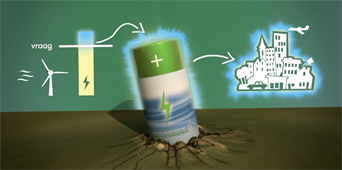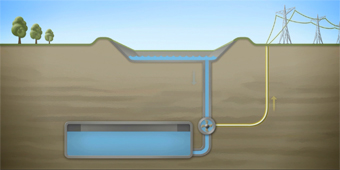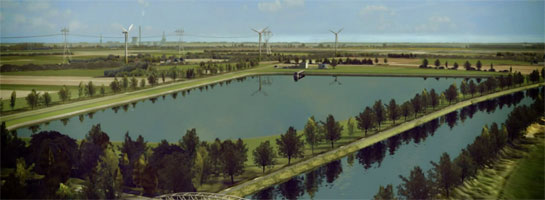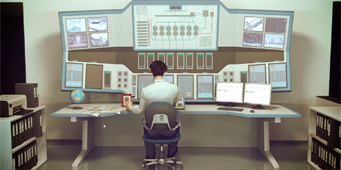FLES – Flat-land Large-scale Electricity Storage
The projected large scale wind power in Germany, UK, France and surrounding countries faces more and more difficulties to match supply and demand. Almost all Northwest European countries hope to solve this problem through import and export, trying to balance surpluses and shortages with neighbouring countries. However, this will not be sufficient to safely absorb all the power from the future Northwest European wind parks, without jeopardizing security of supply. The wind blows in the whole North Sea area at approximately the same times, so that surpluses or shortages will occur nearly always simultaneously. The installed wind capacity will be so high that supply will often exceed demand, especially during the off-peak hours, and lots of renewable energy might get lost.
The European Commission and countries as Germany are convinced that growth of renewable sources requires a smarter electricity grid in which multiple solutions for large scale storage have to be integrated. It is inevitable that electricity storage can increase the value of the available wind power by making it more demand driven. It’s a necessity for governments spending large amounts of subventions to finance production of wind power and (on the mid-long term) also for the wind park owners, since subventions will definitely not be everlasting.

The European network requires more than one storage solution. Pumped storage, a proven technology for several decades, still is the most valid option.
Most European countries have large storage systems in place which provide extra amounts of flexibility to their energy production mix. However, the capacity of the existing facilities is by far not sufficient to accommodate future wind power and other renewable
resources.

Conventional pumped storage requires an environment with large differences in height. New locations for additional capacity are hardly or not to find Northwest Europe. For ecological reasons mountainous areas mostly do not allow construction of large water reservoirs and hydro electric installations. Furthermore potential locations are not ideally located: too far from densely populated areas with large electricity consumption and too far from renewable energy production (offshore wind parks).
The solution is found in the Flat-land Large-scale Electricity Storage (FLES).
O-PAC the Dutch example
In the eighties, after closing the coal mines in the Netherlands, the Dutch government has assigned a study to the Technical University of Delft, an engineering company and our enterprise, in order to determine whether mentioned coal mines could be used for pumped storage / large scale electricity storage. After scientific research it was concluded that pumped storage is not feasible using these coal mines as lower water reservoir, for both technical and economic reasons.
However, the research was continued and lead to a new concept in which solid rock formations below the (unstable) coal layers are used to excavate the lower water reservoir for pumped storage. This concept is based on proven technology.
Considering the growing importance of sustainable energy sources, above-mentioned studies were recently updated, showing that the concept is feasible. On request of the Province of Limburg also the economic feasibility was checked and confirmed by
Ernst & Young.
Furthermore we co-operate with the RWTH Aachen which supports the concept.

Since the geographical conditions in the Netherlands are not suitable for realizing conventional pumped storage, this flat land solution was developed to create underground pumped storage (O-PAC). O-PAC will build the lower water reservoir deeply underground in strong homogeneous rock formations, so that there is only one water basin visible in the landscape.
Compared with conventional pumped storage the impact on the environment is significantly less. First of all less vulnerable locations are eligible for this solution. Besides that, the reservoir on the surface (only one instead of two) can be much smaller since the difference in height can be maximized. More height difference between the reservoirs implies that less water is required
(energy = height x water volume).
For a specific location in the Netherlands a complete plan for an underground pumped storage power plant was worked out.
The technical details were checked and approved by well-known engineering companies.
Since locations for conventional pumped storage are scarce, the Dutch underground version O-PAC can offer also a solution for other European countries (e.g. Germany), that wish to expand renewable energy production significantly. Pumped storage makes these new sources more cost effective. For new (European) locations to be studied, data may vary depending on a.o. the depth of suitable rock formations.
The Dutch O-PAC concept is an attractive business proposition for the future ´green´ energy market. This underground pumped storage power plant will have a capacity of 1400 MW (daily output of 8 GWh). An appropriate site for the project has been secured near
Maastricht, in the south of the Netherlands. The total investment amounts between EUR 1.600 and 1.800 million. The project's equity needs to be circa EUR 600 million. Depending from future market developments several scenario’s have been calculated, leading to a very attractive return on equity.


Due to the great importance for the regional economy, especially employment, the local governments are highly interested. Therefore O-PAC will be a 50/50 Public Private Partnership, in which one or more private parties are invited to participate for the other 50%. Some long term investors are interested to participate. A final investment decision is to be taken after two years preparation time.
From then it will take circa five years to build O-PAC.
To finalize the development of the project (further engineering, permits, geological preparations etc.) towards a final investment
decision a dedicated company, OPAC Ontwikkelingsmij BV has been established. The required budget is also financed through a Public Private Partnership. Participating private parties financing can count on either an attractive exit at the final investment decision
or a preferential position in the project’s financing afterwards.
See also: www.o-pac.nl
